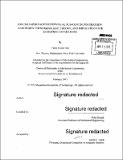| dc.contributor.advisor | Rohit Karnik. | en_US |
| dc.contributor.author | Jain, Tarun (Tarun Kumar) | en_US |
| dc.contributor.other | Massachusetts Institute of Technology. Department of Mechanical Engineering. | en_US |
| dc.date.accessioned | 2015-07-31T19:09:15Z | |
| dc.date.available | 2015-07-31T19:09:15Z | |
| dc.date.copyright | 2015 | en_US |
| dc.date.issued | 2015 | en_US |
| dc.identifier.uri | http://hdl.handle.net/1721.1/97969 | |
| dc.description | Thesis: Ph. D., Massachusetts Institute of Technology, Department of Mechanical Engineering, 2015. | en_US |
| dc.description | Cataloged from PDF version of thesis. | en_US |
| dc.description | Includes bibliographical references (pages 113-118). | en_US |
| dc.description.abstract | Atomically thin materials, and in particular graphene, provide a new class of solid-state nanopores - apertures that allow for the exchange of matter across thin membranes - with the smallest possible volumes of any ion channel. As the diameter of these nanopores becomes comparable to that of hydrated ions, sub-continuum effects have the potential to enable selective transport similar to that observed in biological ion channels. Being substantially thinner than its biological counterparts, the atomic thickness of graphene places it in a new physical regime with ultimate permeance and distinct geometric constraints on atomic interactions. Engineering graphene nanopores with both high permeance and selectivity has major implications for industrial separation processes, including reverse osmosis, nanofiltration, electrodialysis, metal cation separations, and proton exchange membranes. However, phenomenological measurements on the behavior of single sub-2 nm pores have been extremely limited and the mechanisms of ion transport remain unclear. In this thesis, the behaviors of sub-2 nm graphene nanopores are experimentally characterized, and a theoretical model is developed that quantitatively matches many of the observed transport features. Inspired by the patch-clamp method for measuring ion channels, a method is developed for statistically isolating individual graphene nanopores by reducing the graphene area under test. The conductances of sub-2 nm graphene nanopores were found to span two orders of magnitude below that of larger graphene nanopores reported so far. Different graphene pores were found to display distinct trends in cation selectivity, as well as nonlinear ionic transport such as voltage-activated and rectified current-voltage curves. Furthermore, in rare instances, nanopores exhibited real-time voltage gating where the nanopore switches between two states in a voltage-dependent manner. The set of these behaviors are in fact highly reminiscent of biological ion channels and deviate from those of larger solid-state nanopores. A theoretical model consisting of electromigration over an energy landscape defined by ion dehydration and electrostatic interactions was able to accurately model the nonlinear conductance characteristics of graphene nanopores, and provided evidence that voltage gating is consistent with proton or ion binding/unbinding in the vicinity of the nanopore. Switching gears, a new measurement platform was developed that can measure large numbers of graphene nanopores, with the aim of performing high-throughput characterization of an entire distribution of nanopores in a graphene membrane. By developing a method to integrate solid-state nanopores into microfluidic devices, and leveraging active microfluidic components for electrical multiplexing, measurements over multiple solid-state and graphene nanopores in a single device were demonstrated. In conclusion, this study presents experimental insight into the behaviors of a new class of two-dimensional solid-state nanopores and elucidates the mechanisms of ion transport in these structures. The mechanistic understanding of transport is expected to guide the engineering of graphene nanopores with both high permeance and selectivity, and the high-throughput platform for testing graphene nanopores will enable rapid screening of graphene nanopore fabrication methods. | en_US |
| dc.description.statementofresponsibility | by Tarun Kumar Jain. | en_US |
| dc.format.extent | 118 pages | en_US |
| dc.language.iso | eng | en_US |
| dc.publisher | Massachusetts Institute of Technology | en_US |
| dc.rights | M.I.T. theses are protected by copyright. They may be viewed from this source for any purpose, but reproduction or distribution in any format is prohibited without written permission. See provided URL for inquiries about permission. | en_US |
| dc.rights.uri | http://dspace.mit.edu/handle/1721.1/7582 | en_US |
| dc.subject | Mechanical Engineering. | en_US |
| dc.title | Ion transport across individual sub-continuum graphene nanopores : phenomenology, theory, and implications for industrial separations | en_US |
| dc.type | Thesis | en_US |
| dc.description.degree | Ph. D. | en_US |
| dc.contributor.department | Massachusetts Institute of Technology. Department of Mechanical Engineering | |
| dc.identifier.oclc | 913960169 | en_US |
